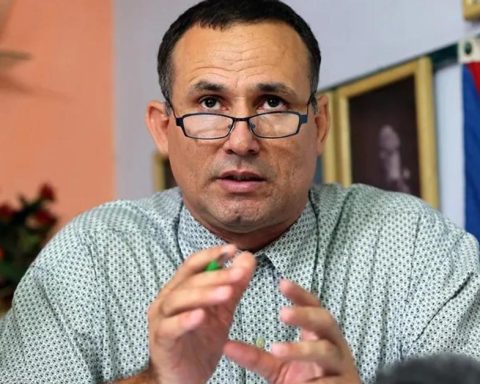
The ICOVID Chile team, an initiative led by the University of Chile, the Pontifical Catholic University of Chile and the University of Concepción, presented its 69th report with analysis and data on the dimensions proposed to monitor the pandemic in the country, with information obtained up to on Sunday, January 2, 2022, provided through an agreement with the Ministry of Health and the Ministry of Science, Technology, Knowledge and Innovation.
According to the new report, after having reached an intermediate risk level (orange between 1 and 5 per 100,000 inhabitants), the burden rose sharply, reaching 9.5 per 100,000 inhabitants with a confidence interval of 10. As a context, the Researchers explain that “the outbreak of the delta variant had a maximum load of 11.2 per 100,000, so it is to be expected that in the next few days the current outbreak will exceed the outbreak per delta.”
Observing the situation in regions, the highest national burden was in Tarapacá (74.5), Arica and Parinacota (24.5), Aysén (22.0), Los Ríos (21.0) and Magallanes (20.2). Meanwhile, the lowest loads were registered in O’Higgins (4.8), Metropolitana (5.1), and Maule (7.3).
On the other hand, the effective reproduction number R, which represents the average number of people contagious in each case, shows that the transmission was on the rise, turning red, with the mean of 1.12. According to the document, the figure for this indicator is “rising rapidly to possibly reach in the next few days the maximum level of R effective in the outbreak of the delta variant, which reached 1.29 on October 13”.
Likewise, in regions, the highest transmission rates were in Tarapacá (2.9), Arica and Parinacota (1.8) and Magallanes (1.35), areas of high exchange of travelers. The Metropolitan Region, Antofagasta, La Araucanía, Aysén and O’Higgins also stand out with levels between 1.24 and 1.21, all with growing infection. The lowest transmission rates occurred in Los Lagos (0.92) and Los Ríos (1.07).
Before the scenario, the epidemiologist and academic from the Faculty of Medicine of the Pontificia Universidad Católica de Chile, Catterina Ferreccio, pointed out that “we are initiating a new epidemic outbreak of covid-19 in the country, obviously the person responsible is the new omicron variant that infects the unvaccinated and also those vaccinated with three doses and people who were previously infected with other variants. Although the main origin of the cases is international travelers, community transmission is clear. A sharp rise in hospital demand can only be prevented by reducing the rate of contact between people, this is to reduce the capacity both in activities indoors and outdoors ”.
Regarding positivity at the national level, after several days in green, the indicator rose to 2.8% as an average for the week ending January 2. In fact, it exceeded 5% (red color) in the regions of Tarapacá and Los Ríos; and above 3% (orange color) were La Araucanía, Biobío, Valparaíso, Los Lagos and Aysén with levels between 4.2 and 3.5.
The report also indicates that after a drop in the testing rate, in the last days of December it began to increase at the national level, reaching 16.0. Meanwhile, at the regional level, the highest testing rates were in the extreme north: Arica and Parinacota (27.8), Tarapacá (26.2), Atacama (25.3), and the extreme south: Magallanes (23.8) , Aysén (22.5) and Los Lagos (22.0). The lowest rate was in O’Higgins (9.5).
Indeed, as the engineer and academic from the University of Chile, Marcelo Olivares, emphasizes, “Chile has managed to position itself as a leader in the vaccination campaign, with 58% of the population having a full vaccination campaign and booster doses, compared to 6.7% worldwide. However, the wave of infections observed in other countries should keep us alert to a possible new wave. We have a good testing capacity to detect new cases, but it is vital that the population is responsible for any signs of symptoms to consult, detect and isolate cases early. We must not lower our guard ”.
Along these lines, on the traceability dimension, the early confirmation indicator, that is, the proportion of suspicious symptomatic people whose laboratory result is reported to the health authority within three days from the date of onset of symptoms, has been steadily improving. , being this last week at its best performance with 65%, increasing from 40% at the beginning of 2021. “This increase is mainly due to the notable reduction in examination and laboratory times,” says the report.
This indicator is relatively homogeneous in all regions of Chile, ranging from 73% to 96%. The poorest indicator is in Tarapacá, followed by Coquimbo with 75%. Atacama and Maule stand out with 96% of tests reported within 24 hours.
For its part, the early consultation indicator, which calculates the proportion of people who had a medical consultation in two days or less since symptoms began, has shown a stagnation in the 50-60% range throughout the year 2021, without presenting sustained improvements. The only regions that currently exceed 65% are O’Higgins, Maule, Tarapacá, Atacama and Arica and Parinacota, the latter with a good indicator of 79%. There are eight regions with the early consultation indicator close to 55-57%, showing a deficient level (orange color).
“Given that the peak of viral load occurs around the time of onset of symptoms, infected people are highly infectious in the days following the onset of symptoms and each day that their isolation accelerates is key to reducing transmission. Therefore, it is very important to continue working to improve this indicator, for which we alert the population to consult a doctor as soon as possible when any symptoms indicative of illness appear (including mild symptoms such as nasal congestion, pain headache or muscle fatigue), whether or not he is vaccinated ”, point out the researchers.
Regarding the hospital dimension, around 27% of ICU beds are occupied by covid-19 patients nationwide, a figure that has been decreasing since December, when it was 34% on average throughout the country. To put it into perspective, at the peak of occupancy during 2021, 75% of ICU beds were occupied by patients with covid-19, more than double the current level.
However, there are regions where the occupancy of ICU beds by covid-19 patients is much higher, which suggests caution. The Aysén Region stands out, which since December has remained above 60%, although it has decreased in the last two weeks. In the Los Lagos Region, occupancy has risen steadily since December, increasing from 30% at the beginning of December to 56% this last week (almost double in four weeks).
Likewise, the Biobío Region had been increasing its ICU occupancy of covid-19 patients at a similar rate, reaching a peak in the week of December 12 and then showing a stabilization around 47%. The Magallanes Region has also presented a significant increase, rising from 28% to 45% in the last two weeks. The rest of the regions are at relatively stable levels.
Critical covid-19 patients generate a saturation of the critical bed system that can also affect the care of other pathologies. Therefore, “it is important to maintain continuous monitoring of the ICU bed occupancy in its entirety. This indicator has remained stable between 85-90% from October to date, which corresponds to the color red, and is currently at 87.6% ”, emphasize the researchers.
In addition, the report indicates that total ICU occupancy is particularly high in the Los Lagos Region, over 94% during the last three weeks, and in the Biobío and Metropolitan regions, where it has remained at around 90% in the same period. The Antofagasta and Valparaíso regions are at high levels (close to 88%), but they have shown a decrease compared to the previous two weeks (when they were at approximately 95%).
When breaking down the hospital occupancy data by age, it is observed that the variation in the occupancy of ICU beds by covid-19 patients is homogeneous between age groups: all of them decreased their occupancy by 7-14% in the last week, a question that was achieved to alleviate at least temporarily the rise in hospitalizations in all age groups that was observed between October and November 2021.
“It is possible that the increase in cases in the last two weeks will translate into an increase in hospitalizations, although in other countries the rate of hospitalization of infected people has been lower than that observed in the period prior to the vaccination campaigns. For this reason, it is essential to maintain continuous monitoring of hospital occupancy to make decisions regarding mitigation measures and management of the health system, ”the report states.
Regarding the vaccination plan, to date, 84% of the national population has received their complete vaccination schedule: 91.4% in those older than 70 years, 94% for the group between 50 and 69 years, 85% in the group 18 and 49 years old and 60% in the minor group (under 18 years old). The data at the local level show variation between regions, where O’Higgins, Ñuble and Aysén stand out with more than 90% vaccinated (considering the entire population), and the Metropolitan and Tarapacá regions present the lowest levels, around 80%. It should be noted that 80% is still high, since countries with that level of vaccination rank within the top 15 worldwide.
Finally, “the most remarkable thing about the vaccination campaign in Chile is the advance with the booster doses,” the researchers state. According to data from Our-World-In-Data, Chile has 58.5% of its population on a full schedule and booster doses, compared to 6.7% worldwide. 11.4 million booster doses have already been administered, corresponding to 69% of the population with a complete schedule.

















